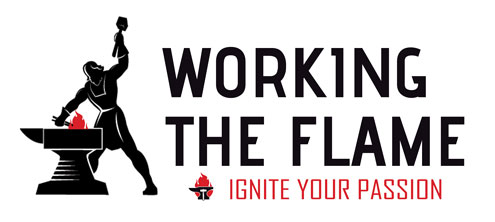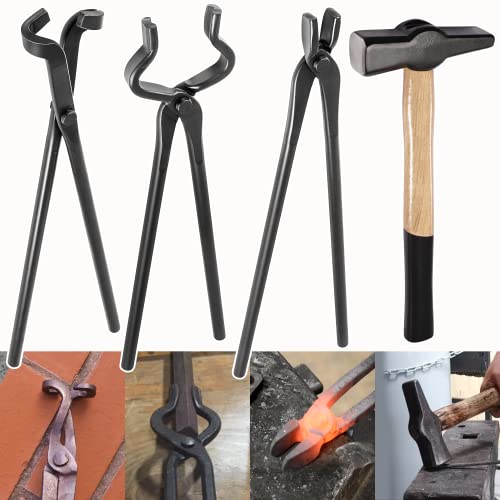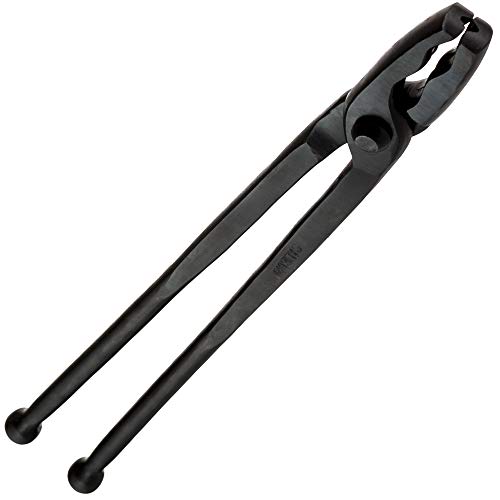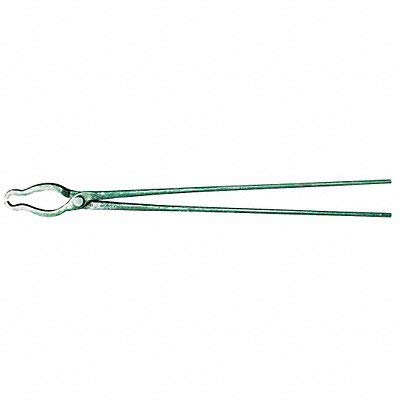Best Types of Blacksmith Tongs, Metalwork Tongs & Forging Tongs (Ultimate List)

Blacksmithing tongs are an important aspect of the hand forging process, second only to the hammer and anvil. They allow us as blacksmiths to manipulate and move the metal workpiece with heightened ease, accuracy and efficiency – as well as keep our fingers in one piece while hammering away!
Since there are so many different shapes to be made with a forging, it is important to note that there is also a variety of tools available to aid in creating those shapes. Oftentimes, blacksmiths tend to custom-make tongs for a specific metalworking project or modify tongs that they already have to fit their individual needs. Since almost all blacksmithing tongs are made in forges to begin with, changing the shape and function is a perfectly viable thing to do if you already have the appropriate forging equipment and expertise. Although certain types of tongs have advantages over others, you can, in most cases, still make a single type suitable for almost any job with some mortification and practice!
- V-Bit Blade Tongs-- Extremely versatile and effective in respect to processing wider flat stock...
- Blade Tongs--Designed for knife-smiths and will allow you to grip the knife in different positions...
- Flat Tongs--For 1/4 inch flat stock. making the tongs lighter and easier to handle when using...
Blacksmith Tong Considerations – What’s Important?
1) The Anatomy of Tongs

It is important to be aware of the different aspects of tongs prior to purchasing them. The handles of tongs are called the reins, which are used by blacksmiths to open and close a pair of tongs. The opening and closing action is facilitated by the joint of the tongs, which is located where the reins meet. The joint is typically made up of a hinge plate and a rivet to secure the two reins together.
The part beyond the joint is known as the jaws or the bits of the tongs, which are the parts of the tongs that actually perform the grasping or gripping action and are in direct contact with the metal workpiece and the forge. Tong jaws are very versatile and can be made in different shapes for different applications.
2) The Length of Tongs

In addition to the variety of tong jaws, tongs in general can come in many different lengths. They can range on average from 15 inches to 40 inches, depending on the application, or how you make them in your own forge. However, it is important to keep in mind that the longer the tongs are, the heavier they weigh. There is a logical tradeoff based on the length of tongs. Long tongs allow you to stay farther away from the hot forge, whereas shorter tongs require you to move closer to the forge and the workpiece.
Depending on your experience, skill and the exact type of project you’re working on, certain lengths could either be a hindrance or a benefit – a good middle-ground, especially as a beginner blacksmith wanting to work with simple projects, would be a length of around 18-22 inches for multi-purpose tongs, such as V-bit bolt tongs, wolf jaw tongs or Z-jaw tongs (read more about these below).
3) The Weight & Type of Tongs

Having tongs that are the appropriate shape for you application not only allows you to firmly hold the metal stock, but it reduces the stress on your hands and wrists while using this tool. The type of tongs you purchase should also be based on your skill level. If you are just starting out as a beginner blacksmith, it may be more useful to purchase tongs that can accomplish a variety of projects in which you are interested, such as V-bit or wolf jaw tongs. The size and weight of tongs should also be within your skill limits, but unlike the length, it’s actually quite difficult to recommend an ideal weight, as everyone is different and some prefer a lighter touch and others a heavier grip. When first starting out, it’s often better to simply select an ideal length range (as mentioned) for your tong of choice, and then pick-up a high quality pair from a reputable brand who know what they’re doing.
However, typically, most beginners will find it easier to start with a lighter set of tongs in order to get used to the movements and physical exertion used during the blacksmithing process.
A lot of blacksmiths, even more patient beginners, can still forge their own tongs based on their particular needs and price point. If forging your own tools is not something you want to worry about it, even though it is considered the most economical way to acquire tongs, a lot of the tools listed below are readily available for purchase in online stores in both new and used conditions. You could even opt for a DIY blacksmith tong kit, which include pre-made parts which simply need some assembly for a range of popular tong styles.
Types of Blacksmithing Tongs & Forging Tongs For Beginners & Experts (Pros & Cons)
1) V-bit Bolt Tongs (Great for Beginners Blacksmiths & Bladesmiths)
- This refurbished product is tested and certified to work properly. The product will have minor...
Purpose: Multi-purpose
Difficulty: Easy/Novice
Cost: Medium-High
V-bit tongs, or bolt tongs, have a unique bit shape that has the appearance of a circle near the joint when the tongs are in the closed position and it ends with the bits pointing straight out above the circle. Although the end of the bits may be parallel with the rest of the tong in the closed position, each bit has curved sides that create a hollow v-shape on both sides when looking at their cross section.
V-bit tongs are great for a variety of applications. They are are easy to use and can hold both round and square metal pieces during forging. The ability to grasp objects of different shapes and sizes largely increases the functionality of the tongs, making them a sort of universal tong type. Metal pieces with holes can also be handled with bolt tongs because the ends of the tongs can be easily passed through the hole and can firmly clasp onto the metal.
One of the most common uses of v-bit tongs are knifemaking. The v-bits can form a strong grip around the blade of the knife while the blacksmith shapes it. This feature makes v-bit tongs great bladesmithing tongs.
| Advantages | Disadvantages |
|
|
2) Wolf Jaw Tongs (Great for Beginner Blacksmiths & Bladesmiths)
Purpose: Multi-purpose
Difficulty: Easy/Novice
Cost: Medium-high
Wolf jaw tongs are very popular among blacksmiths and make great beginner tongs for multi-purpose application. They are easy to use and can be relatively light in weight while being tough enough to withstand forging conditions. It has a wavy tooth-like shape that allows it to adapt to different stock shapes and sizes and provide a secure grip.
Since this type of tongs is so versatile it is also a great starter pair for beginners wanting to expand their blacksmith tool arsenal. As an added bonus, and let’s be honest, just the name is pretty cool, as well!
| Advantages | Disadvantages |
|
|
3) Z Offset (Z-Jaw) Tongs (Great for Beginner Bladesmiths)
- ✔️FORGED STEEL CONSTRUCTION - Our tongs are built to last
- ✔️OFFSET, Z-BIT STYLE - Your flat, square, round or other stock is never impeded by the rivet...
- ✔️VERSATILE V-BIT JAWS - These blacksmith tongs are an indispensable addition to your tool...
Purpose: Knife-making (supplementary tongs)
Difficulty: Intermediate
Cost: Medium-high
Z-jaw, or Z Offset tongs have a distinct z-shaped bit that makes it a great choice for knifemaking. They feature and offset structure that accommodates the shape of a knife while holding its blade properly in place while shaping it. Not particularly useful for general purpose forging, but an essential piece of kit for those wanting to specialize more in knife-making or bladesmithng.
Unlike other tongs here, these are quite difficult, especially as a beginner, to forge correctly from a base pair of tongs. For that reason, and because they serve a highly specialized (and important) purpose, we actually recommend simply investing in a quality pair if you’re just starting out!
| Advantages | Disadvantages |
|
|
4) Flat Jaw (Nosed) Tongs(Great for Forging into Other Tongs)
- Flat nosed
- Brand Name: Gedore
- Country of Origin: Germany
Purpose: Flat Stock
Difficulty: Easy/Novice
Cost: Medium-High
Flat jaw tongs, or flat nosed tongs, are used when working with flat metal pieces. They have flat, rectangular bits that are best suited for a flat workpiece. Since flat jaw tongs have a very simple shape, they are easily accessible and often used as a starting material for other tools.
Although flat jaw tongs are very useful on their own, they can be shaped into other types of tongs, such as box jaw, wolf jaw, or v-bit tongs. Their already flat jaw shape makes them very easy to heat up and bend it into a different shape or to increase their structural strength.
| Advantages | Disadvantages |
|
|
5) Duck Bill Tongs
Purpose: Flat stock
Difficulty: Easy/Novice
Cost: Medium-High
Duck bill tongs have a very descriptive name. Their jaws literally have the shape of a duck bill and are mainly used to work with flat workpieces. They can have solid metal bits that clam on the workpiece or loops on each bit through which the edges or corners of the flat metal pieces can be placed. This loop secures the workpiece and allows blacksmiths to move it in their desired direction or simply hold it in place while it is being hammered. Not exactly the most multi-purpose tongs around, but still useful to have on hand and readily malleable into other designs with experience.
| Advantages | Disadvantages |
|
|
6) Box Jaw Tongs
- Securely grip flat stock up to 1-1/2" wide
- Smooth operation
- Ergonomic design allows long days at forge without fatigue
Purpose: Multi-purpose
Difficulty: Easy/Novice
Cost: Medium-High
Box jaw tongs are great for working with flat metal sheets or blades of metal. They have flat surface features at the end of the bits with the bottom side being completely flat, also known as being straight lipped, and the top having raised sides to secure the workpiece within jaws’ grip by fitting over the sides of the bottom jaw. This unique shape produces a firm grasp on the metal workpiece without compromising its shape during the forging process.
Even though box jaw tongs are great for their intended application, they are known to be very dependent on the width of the individual stock. If the stock width is too narrow or too wide, it may not provide the desired snug fit of the blade within the jaws. If the jaws are not able to clamp down directly on the workpiece, the workpiece can be easily dropped because it is too loosely held or it can cause a strain on your hand because you have to tightly grip it so that it does not fall. When working with stock of inconsistent widths, it may be easier to make box tongs of different jaw widths to accommodate the particular project. Box tongs are relatively easy to forge with the right materials and skill level.
| Advantages | Disadvantages |
|
|
7) Pick-up Tongs & Rivet Tongs
Purpose: Specialized (supplementary)
Difficulty: Easy/Novice
Cost: Medium-High
Pickup tongs are similar to bent knee tongs in the sense that they also serve as a tool to pick up workpieces, as their name suggests. Pickup tongs are great for picking up hot metals safely and steadily. Their wavy bits make them great for picking up and holding round pieces or rivets. These tongs are also great for holding chiseling tools up to a workpiece. They are a good supplement to hammers when shaping a metal.
Rivet tongs have bits that are curved inward to form the shape of a circle when they are close together. Their curved ends can best be used to pick up rivets. Since they have a similar design as pickup tongs, rivet tongs can also be used to hold chiseling tools in place depending on their size.
| Advantages | Disadvantages |
|
|
8) Bent Knee Tongs
Purpose: Flat stock
Difficulty: Intermediate
Cost: Low
Bent knee tongs feature bits that are bent at nearly a 90 degree angle. The purpose of these tongs is to allow a blacksmith to easily pick up a flat workpiece from a lower height. The bent angle makes the pick up action much easier from a standing position if the piece that is meant to be picked up is on the forge floor or on a low table. Bent knee tongs can also pick up metal objects or forgings with hollow shapes.
| Advantages | Disadvantages |
|
|
9) Hammer Tongs
Purpose: Hammer heads
Difficulty: Intermediate
Cost: Low
The main purpose of hammer tongs is to forge hammer heads. They allow you to firmly grip the hammer head during forging, minimizing the chances of having the workpiece slip through the tool or dropping it. The ends of hammer tong bits generally curve inward to form a closed loop, but there are hammer tongs whose bits curve outward at the ends in order to fit them through the hole at the central axis of the hammer head. This hole is known as the eye of the hammer head and the ability to hold the hammer head from that location makes it very easy to rotate and manipulate the hammer head when shaping it.
| Advantages | Disadvantages |
|
|
10) Spreading Tongs
Purpose: Specialized (supplementary)
Difficulty: Intermediate
Cost: Low
Detailed metalworking usually calls for spreading tongs. This type of tongs is perfect for bending metal into intricate shapes. Some of the applications for which spreading tongs are used are spiral metal baskets or scrolls. Although this type of togs is great for shaping metal, using it is not very intuitive, because its ends actually open wide when you squeeze the reins, which is the opposite mechanism of most other tongs.
| Advantages | Disadvantages |
|
|









